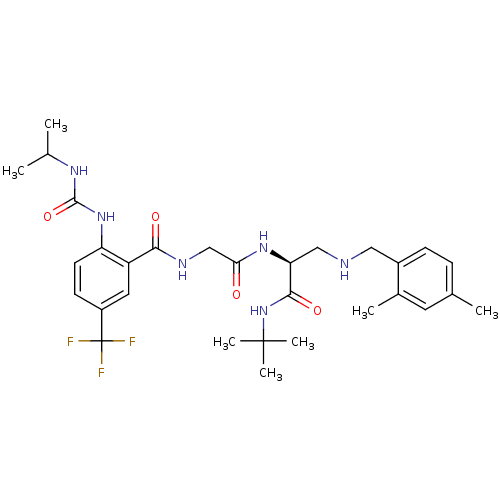

 Search and Browse
Search and Browse
 Download
Download
 Enter Data
Enter Data
BDBM50219850 (S)-1-(2-((2-(3-(2,4-dimethylbenzylamino)-1-(tert-butylamino)-1-oxopropan-2-ylamino)-2-oxoethyl)carbamoyl)-4-(trifluoromethyl)phenyl)-3-isopropylurea::CHEMBL247455
SMILES: CC(C)NC(=O)Nc1ccc(cc1C(=O)NCC(=O)N[C@@H](CNCc1ccc(C)cc1C)C(=O)NC(C)(C)C)C(F)(F)F
InChI Key: InChIKey=AWJUKDQERXTXHY-UHFFFAOYSA-N
Data: 4 IC50
| Target/Host (Institution) | Ligand | Target/Host Links | Ligand Links | Trg + Lig Links | Ki nM | ΔG° kcal/mole | IC50 nM | Kd nM | EC50 nM | koff s-1 | kon M-1s-1 | pH | Temp °C |
|---|---|---|---|---|---|---|---|---|---|---|---|---|---|
| C-C chemokine receptor type 2 (Human) | BDBM50219850 ((S)-1-(2-((2-(3-(2,4-dimethylbenzylamino)-1-(tert-...) | GoogleScholar | UniChem | n/a | n/a | 240 | n/a | n/a | n/a | n/a | n/a | n/a | |
TBA | Citation and Details | ||||||||||||
| More data for this Ligand-Target Pair | |||||||||||||
| C-C chemokine receptor type 3 (Human) | BDBM50219850 ((S)-1-(2-((2-(3-(2,4-dimethylbenzylamino)-1-(tert-...) | GoogleScholar | UniChem | n/a | n/a | 1.00E+4 | n/a | n/a | n/a | n/a | n/a | n/a | |
TBA | Citation and Details | ||||||||||||
| More data for this Ligand-Target Pair | |||||||||||||
| C-C chemokine receptor type 2 (Human) | BDBM50219850 ((S)-1-(2-((2-(3-(2,4-dimethylbenzylamino)-1-(tert-...) | GoogleScholar | UniChem | n/a | n/a | 15 | n/a | n/a | n/a | n/a | n/a | n/a | |
TBA | Citation and Details | ||||||||||||
| More data for this Ligand-Target Pair | |||||||||||||
| C-C chemokine receptor type 2 (Human) | BDBM50219850 ((S)-1-(2-((2-(3-(2,4-dimethylbenzylamino)-1-(tert-...) | GoogleScholar | UniChem | n/a | n/a | 58 | n/a | n/a | n/a | n/a | n/a | n/a | |
TBA | Citation and Details | ||||||||||||
| More data for this Ligand-Target Pair | |||||||||||||